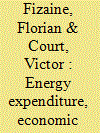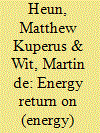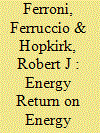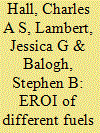|
|
|
Sort Order |
|
|
|
Items / Page
|
|
|
|
|
|
|
| Srl | Item |
| 1 |
ID:
150800


|
|
|
|
|
| Summary/Abstract |
We performed a comprehensive and internally consistent assessment of the energy performance of the full range of electricity production technologies in the United Kingdom, integrating the viewpoints offered by net energy analysis (NEA) and life cycle assessment (LCA). Specifically, the energy return on investment (EROI), net-to-gross energy output ratio (NTG) and non-renewable cumulative energy demand (nr-CED) indicators were calculated for coal, oil, gas, biomass, nuclear, hydro, wind and PV electricity. Results point to wind, and to a lesser extent PV, as the most recommendable technologies overall in order to foster a transition towards an improved electricity grid mix in the UK, from both points of view of short-term effectiveness at providing a net energy gain to support the multiple societal energy consumption patterns, and long-term energy sustainability (the latter being inversely proportional to the reliance on non-renewable primary energy sources). The importance to maintain a sufficient installed capacity of readily-dispatchable gas-fired electricity is also recognised.
|
|
|
|
|
|
|
|
|
|
|
|
|
|
|
|
| 2 |
ID:
171524


|
|
|
|
|
| Summary/Abstract |
A widespread implicit assumption is that renewable energy options are approximately low-carbon. However, production and life cycles of such technologies tend to produce CO2 emissions. To minimize life-cycle emissions, one should account for such emissions and implement adequate policies to encourage innovation and adoption of well-performing technologies in this respect. We develop a framework to analyse this issue, grounded in the concepts of ‘energy return on energy invested’ (EROI) and ‘net energy return on carbon invested’ (EROC). Applying these to the main PV technologies and production regions – namely China, EU and USA – displays considerable discrepancies. We conditionally predict the development of average EROI and EROC over time under business-as-usual and low-carbon electricity generation scenarios. A main policy lesson is that without a systemic policy instrument, such as carbon pricing, incentives for low-carbon production of renewable energy options are too weak, which likely will delay a complete transition to a low-carbon economy.
|
|
|
|
|
|
|
|
|
|
|
|
|
|
|
|
| 3 |
ID:
166723


|
|
|
|
|
| Summary/Abstract |
A number of official energy forecasts—including those compatible with the aspirational 1.5 °C Paris Accord global temperature rise limit—see both global primary and net energy use continuing to rise, even out to 2100. Various technologies, including greatly increased use of renewable and nuclear energy, negative emission technologies such as direct air capture, and geoengineering are proposed as approaches for meeting the 1.5 °C target. In contrast, we argue that meeting this target and avoiding significant increases in extreme weather events will require marked reductions in future energy demand. We argue that the combined fossil fuel and renewable net green energy production will fall in the coming decades, after subtraction of various energy costs essential for ecosystems maintenance, including those needed to stabilise climate. At best, nuclear energy will only fractionally increase its global energy share, because of its high capital costs and political opposition arising from accident risks, waste disposal and proliferation concerns. Geoengineering will not solve fossil fuel depletion, and has serious known—and perhaps unknown—risks. We conclude that global net energy produced in an ecologically sustainable manner will start falling in a decade or so, and suggest the need to account for this at a policy level by introduction of a green EROI—EROIg.
|
|
|
|
|
|
|
|
|
|
|
|
|
|
|
|
| 4 |
ID:
150735


|
|
|
|
|
| Summary/Abstract |
We estimate energy expenditure for the US and world economies from 1850 to 2012. Periods of high energy expenditure relative to GDP (from 1850 to 1945), or spikes (1973–74 and 1978–79) are associated with low economic growth rates, and periods of low or falling energy expenditure are associated with high and rising economic growth rates (e.g. 1945–1973). Over the period 1960–2010 for which we have continuous year-to-year data for control variables (capital formation, population, and unemployment rate) we estimate that, statistically, in order to enjoy positive growth, the US economy cannot afford to spend more than 11% of its GDP on energy. Given the current energy intensity of the US economy, this translates in a minimum societal EROI of approximately 11:1 (or a maximum tolerable average price of energy of twice the current level). Granger tests consistently reveal a one way causality running from the level of energy expenditure (as a fraction of GDP) to economic growth in the US between 1960 and 2010. A coherent economic policy should be founded on improving net energy efficiency. This would yield a “double dividend”: increased societal EROI (through decreased energy intensity of capital investment), and decreased sensitivity to energy price volatility.
|
|
|
|
|
|
|
|
|
|
|
|
|
|
|
|
| 5 |
ID:
111069


|
|
|
|
|
| Publication |
2012.
|
| Summary/Abstract |
Very little work has been done so far to model, test, and understand the relationship between oil prices and EROI over time. This paper investigates whether a declining EROI is associated with an increasing oil price and speculates on the implications of these results on oil policy. A model of the relationship between EROI and oil market prices was developed using basic economic and physical assumptions and non-linear least-squares regression models to correlate oil production price with EROI using available data from 1954-1996. The model accurately reflects historical oil prices (1954-1996), and it correlates well with historical oil prices (1997-2010) if a linear extrapolation of EROI decline is assumed. As EROI declines below 10, highly non-linear oil price movements are observed. Increasing physical oil scarcity is already providing market signals that would stimulate a transition away from oil toward alternative energy sources. But, price signals of physical oil scarcity are not sufficient to guarantee smooth transitions to alternative fuel sources, especially when there is insufficient oil extraction technology development, a declining mark-up ratio, a non-linear EROI-cost of production relationship, and a non-linear EROI-price relationship.
|
|
|
|
|
|
|
|
|
|
|
|
|
|
|
|
| 6 |
ID:
150679


|
|
|
|
|
| Summary/Abstract |
Many people believe renewable energy sources to be capable of substituting fossil or nuclear energy. However there exist very few scientifically sound studies, which apply due diligence to substantiating this impression. In the present paper, the case of photovoltaic power sources in regions of moderate insolation is analysed critically by using the concept of Energy Return on Energy Invested (ERoEI, also called EROI). But the methodology for calculating the ERoEI differs greatly from author-to-author. The main differences between solar PV Systems are between the current ERoEI and what is called the extended ERoEI (ERoEI EXT). The current methodology recommended by the International Energy Agency is not strictly applicable for comparing photovoltaic (PV) power generation with other systems. The main reasons are due to the fact that on one hand, solar electricity is very material-intensive, labour-intensive and capital-intensive and on the other hand the solar radiation exhibits a rather low power density.
|
|
|
|
|
|
|
|
|
|
|
|
|
|
|
|
| 7 |
ID:
113469


|
|
|
|
|
| Publication |
2012.
|
| Summary/Abstract |
A high energy return on energy investment (EROI) of an energy production process is crucial to its long-term viability. The EROI of conventional thermal electricity from fossil fuels has been viewed as being much higher than those of renewable energy life-cycles, and specifically of photovoltaics (PVs). We show that this is largely a misconception fostered by the use of outdated data and, often, a lack of consistency among calculation methods. We hereby present a thorough review of the methodology, discuss methodological variations and present updated EROI values for a range of modern PV systems, in comparison to conventional fossil-fuel based electricity life-cycles.
|
|
|
|
|
|
|
|
|
|
|
|
|
|
|
|
| 8 |
ID:
169712


|
|
|
|
|
| Summary/Abstract |
Effective policy requires comprehensive analysis of many factors. But presently there does not exist a sufficiently comprehensive research on the interrelationship between energy input and output, carbon emissions, and water use in the oil and gas extraction process. To more comprehensively measure this phenomenon, this paper constructs an assessment model of energy return on energy, carbon, and water investment for the development of oil and gas resources using the Daqing and Shengli oilfields as practical examples. The results show that the method for evaluating energy input and output (energy return on energy invested) can be made more comprehensive for covering the resources required in the oilfield extraction process; this method ignores the environmental impacts of carbon emissions (energy return on carbon) and water use (energy return on water). However, the energy return evaluation method, which considers energy, carbon, and water inputs, is more comprehensive and practically used to evaluate the development status of oil and gas resources as well as other types of energy development processes. Policy implications for biophysical input accounting and the management of energy resource extraction are given accordingly.
|
|
|
|
|
|
|
|
|
|
|
|
|
|
|
|
| 9 |
ID:
126821


|
|
|
|
|
| Publication |
2014.
|
| Summary/Abstract |
The near- and long-term societal effects of declining EROI are uncertain, but probably adverse. A major obstacle to examining social implications of declining EROI is that we do not have adequate empirical understanding of how EROI is linked, directly or indirectly, to an average citizen's ability to achieve well-being. To evaluate the possible linkages between societal well-being and net energy availability, we compare these preliminary estimates of energy availability: (1) EROI at a societal level, (2) energy use per capita, (3) multiple regression analyses and (4) a new composite energy index (Lambert Energy Index), to select indicators of quality of life (HDI, percent children under weight, health expenditures, Gender Inequality Index, literacy rate and access to improved water). Our results suggest that energy indices are highly correlated with a higher standard of living. We also find a saturation point at which increases in per capita energy availability (greater than 150 GJ) or EROI (above 20:1) are not associated with further improvement to society.
|
|
|
|
|
|
|
|
|
|
|
|
|
|
|
|
| 10 |
ID:
126820


|
|
|
|
|
| Publication |
2014.
|
| Summary/Abstract |
All forms of economic production and exchange involve the use of energy directly and in the transformation of materials. Until recently, cheap and seemingly limitless fossil energy has allowed most of society to ignore the importance of contributions to the economic process from the biophysical world as well as the potential limits to growth. This paper centers on assessing the energy costs of modern day society and its relation to GDP. Our most important focus is the characteristics of our major energy sources including each fuel's energy return on investment (EROI). The EROI of our most important fuels is declining and most renewable and non-conventional energy alternatives have substantially lower EROI values than traditional conventional fossil fuels. At the societal level, declining EROI means that an increasing proportion of energy output and economic activity must be diverted to attaining the energy needed to run an economy, leaving less discretionary funds available for "non-essential" purchases which often drive growth. The declining EROI of traditional fossil fuel energy sources and the effect of that on the world economy are likely to result in a myriad of consequences, most of which will not be perceived as good.
|
|
|
|
|
|
|
|
|
|
|
|
|
|
|
|
| 11 |
ID:
137652


|
|
|
|
|
| Summary/Abstract |
Cumulative energy demand (CED) estimates from life cycle assessments (LCAs) are increasingly used to determine energy return on investment (EROI), but the difference in indicators can lead to a misclassification of energy flows in the assessment. The core idea of EROI is to measure the relation of energy diverted from society to make energy available to society. CED, on the other hand, includes forms of energy that are not appropriated by society, such as fugitive methane emissions from oil wells as well as losses of heating value of coal during transport and storage. Such energy forms should be excluded from EROI; failure to do so leads to results that are inconsistent with the intention of EROI and potentially misleading. We demonstrate how this problem is at least partially rectifiable by adopting consistent energy accounting, but also note that among the energy flows not appropriated by society occurring in CED, not all flows can easily be removed. Further, we point to inconsistencies in heating value assumptions in a widely used database that have misled analysts. Finally, we argue that the differential weighting of primary energy forms in published CED-based EROI work is unsubstantiated and should be reconsidered.
|
|
|
|
|
|
|
|
|
|
|
|
|
|
|
|
| 12 |
ID:
110387


|
|
|
|
|
| Publication |
2011.
|
| Summary/Abstract |
Historic profitability of bringing oil to market was profound, but most easy oil has been developed. Higher cost resources, such as tar sands and deep off-shore, are considered the best prospects for the future. Economic modelling is currently used to explore future price scenarios commensurate with delivering fuel to market. Energy policy requires modelling scenarios capturing the complexity of resource and extraction aspects as well as the economic profitability of different resources. Energy-return-on-investment (EROI) expresses the profitability of bringing energy products to the market. Net energy yield (NEY) is related to the EROI. NEY is the amount of energy less expenditures necessary to deliver a fuel to the market. This paper proposes a pattern for EROI of oil production, based on historic oil development trends. Methodology and data for EROI is not agreed upon. The proposed EROI function is explored in relation to the available data and used to attenuate the International Energy Agency (IEA) world oil production scenarios to understand the implications of future declining EROI on net energy yield. The results suggest that strategies for management and mitigation of deleterious effects of a peak in oil production are more urgent than might be suggested by analyses focussing only on gross production.
|
|
|
|
|
|
|
|
|
|
|
|
|
|
|
|
|
|
|
|
|